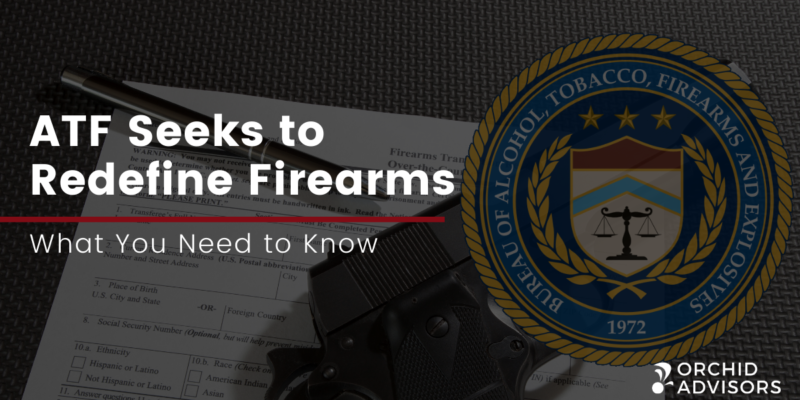On Friday, May 7, it was announced that the Attorney General signed proposed rule 2021R-05, “Definition of ‘Frame or Receiver’ and Identification of Firearms.” The proposed rule has yet to be published in the Federal Register.
As the title implies, the proposed rule seeks to amend the regulatory definitions of “frame or receiver”. In short, the changes are proposed to specify what must be marked and when it must be marked. The rule also includes numerous other proposed amendments to the federal firearms regulations that have the potential for substantial impact to the industry and how it operates. While the proposals clarify come issues faced daily by FFLs they also introduce numerous questions and create additional ambiguities that FFLs will have to grapple with should the proposals be implemented. Below is a summary of the changes proposed by 2021R-05:
Definition of “Firearm”
The proposed rule explicitly states that “weapons parts kits” with “80% receivers” are “firearms” under federal law. As such, manufacturers and dealers of these kits must be licensed, the firearms must be marked, and transfers to unlicensed consumers must be made following execution of a Form 4473 and undergoing a background check (subject to the background check exemptions that currently exist). Manufacturers of such kits must also pay the Firearms and Ammunition Excise Tax for these kits.
The definition would also be modified to explicitly exclude from the definition of “firearm” frames or receivers which have been destroyed.
Definition of “Frame or Receiver”
Perhaps the most extensive changes involve re-defining “frame or receiver.” The proposal calls for a very lengthy multi-part definition of the terms “frame or receiver.” The first section would be a general definition with examples (including images) to illustrate. Second would be a definition of “firearm muffler or silencer frame or receiver”. The third section would define “split or modular frame or receiver”. This would also include examples with images in the regulatory text. Fourth would be a definition of “partially complete, disassembled, or inoperable frame or receiver.” And finally, a definition of “destroyed frame or receiver” to assist in identifying such items not subject to regulation.
These changes have the potential for extensive impact. With respect to silencers, the effect of the rule could mean serializing and marking several portions of tubeless silencers, which are only increasing in popularity. It would also remove the ability of silencer manufacturers to serialize components such as end caps (which will therefore further reduce ability to deal with repairs and will invariably delay the repair process when replacement of serialized parts is necessary). With respect to “split or modular” frames or receivers, the potential impact for placing of multiple serial numbers is the same and ATF explicitly acknowledges that fact in the notice.
With respect to split/modular receivers, ATF did state that they have made determinations of what part of the common firearms on the market today is the frame or receiver and that those determinations would not be affected. However, they also state “if there is a present or future split or modular design for a firearm that is not comparable to an existing classification, then the definition of ‘frame or receiver’ would advise that more than one part is the frame or receiver subject to marking and other requirements, unless a specific classification or marking variance is obtained from ATF…” It is unclear at present what modifications to a firearm platform would render something “not comparable to an existing classification” and therefore require serialization of multiple parts of the firearm. ATF advises FFLs to obtain guidance from FATD for new firearms, however, given the extreme time to respond to the industry it is often commercially impractical for companies to obtain such classifications.
The definition for “partially complete, disassembled, or inoperable frame or receiver” introduces great ambiguity and the commentary on the definition is contradictory. It is unclear how this will be applied in practice and the effect it would have on situations such as importing castings.
Definition of “Readily”
This definition is meant to provide guidance to the industry on how ATF views the term “readily” in the context of when an item is “readily convertible” to being an operable firearm and therefore regulated as a firearm.
Definition of Privately Made Firearm
ATF defines this term for the purposes of setting forth new marking requirements in the situation where an FFL obtains a privately made firearm that is not serialized.
Definition of ‘importer’s or manufacturer’s serial number’”
This definition is created also for the purpose of setting froth new marking requirements in the situation where an FFL obtains a privately made firearm that is not serialized. The proposed rules also mandate that in addition to the serial number, the manufacturer’s name and location appear on the receiver and may no longer appear on the barrel or slide. However, the rules exclude from this new mandate firearms “designed and configured before” the rule takes effect. It is unclear on what modifications to existing firearm platforms would result in classification of it being “designed and configured before” or after the rule, and what changes to such platforms ATF would accept without mandating that the manufacturer’s name and location must also appear on the frame or receiver.
Definition of Gunsmith
The proposals redefine gunsmith to make it clear that companies may obtain a Type 01 FFL solely to provide serial number engraving services for non-licensees. In so doing, ATF is overruling ATF Ruling 2010-10 and no longer allowing Type 01 licensees to provide certain manufacturing services for manufacturing FFLs, even when the firearms being services would be received from and returned to the manufacturer.
Marking Requirements for Firearms
The marking proposals seek to codify ATF Ruling 2012-1 which identified 7 days as the permissible time frame to mark firearms after manufacture. In conjunction with new definition of “frame or receiver”, this could mean that multiple parts of firearms and silencers have to be marked within this time frame. Additionally, the proposals seek to put into place a starting point for measurement of this 7 days. The 7 day clock would start running “from completion of the active manufacturing process for the weapon or device, or prior to disposition, whichever is sooner.”
Introduction of this starting point also introduces great ambiguity. ATF states “firearms that are actively awaiting materials, parts, or equipment repair to be completed are still considered to be actively in the manufacturing process.” For manufacturers who sell stripped receivers, assembled receivers, and complete firearms, this could mean that receivers could sit within their facility for weeks, months, years without being marked. If the manufacturer does not know whether it wants to sell a specific receiver as a stripped lower or a fully assembled lower, then that part could be viewed as “awaiting materials or parts” indefinitely and thus not requiring marking. Or, what if a manufacturer has 1,000 receivers on premises, but only 950 bolt catches, 840 hammer pins, 700 safety selectors? Does the manufacturer have to serialize 1,000? 950? 840? 700? This could lead to many questions by IOIs during inspection and creates ambiguity in the serialization requirements.
Marking of Privately Made Firearms
The proposals require FFLs to serialize and mark their name and location (or license number) when they acquire privately made firearms that do not bear a serial number. This marking would have to occur within 7 days of receipt.
Definitions of “Legible”, “Legibly”, “Conspicuous”, and “Conspicuously”
The proposals modify the marking regulations to codify that “the identification markings use exclusively Roman letters…and Arabic numerals…or solely Arabic numerals.” Additionally, “conspicuous” and “conspicuously” would be stated to mean that “the identification markings are capable of being easily seen with normal handling of the firearm…”
Firearm Muffler or Silencer Parts Transferred Between Qualified Licensees
The proposed rule codifies ATF’s current enforcement practice. Manufacturers of silencer parts have to be a licensed FFL (“qualified licensees”) and licensees may manufacture parts and send them to other qualified licensees without serialization or registration obligations.
Accessory Classification Requests
The proposals “further codify ATF’s policy not to evaluate a firearm accessory or attachment ‘unless it is installed on the firearm(s) in the configuration for which it is designed and intended to be used…”
Manufacturer’s and Importer’s A&D Books
The proposed rules mandate that manufacturers and importers consolidate their records of Acquisition and Disposition (separate by regulation) into a single A&D Book. ATF Rulings 2011-1 and 2016-3 allowed for such consolidation – the amendments to the regulations would not require such consolidation. The proposals also further clarify how to move serial numbers from one A&D Book to another A&D Book if an FFL maintains multiple A&D Books (e.g., manufacturing and repair books).
Record Retention
The proposed amendments to the regulations would also mandate that all FFLs maintain all records indefinitely. This would eliminate the ability of an FFL to send in Forms 4473 or A&D Books that are 20+ years old.
ATF’s notice of the proposed rule changes can be viewed here. As the document numbers 115 pages, you may wish to view ATF’s summary here.
Orchid Advisors is closely monitoring the proposed rule changes and will keep its clients and subscribers informed. FFLs are well-advised to prepare their business for the coming changes if the rules pass (although ATF has to take into consideration industry and public feedback, proposed changes often go into effect without modification based on public feedback)
Ready to Learn More About Orchid’s Expanded Offerings? Contact Us Today.
Looking for something else?
Try Orchid Solutions for FFL compliance Software or FFL Law for legal services.







0 Comments